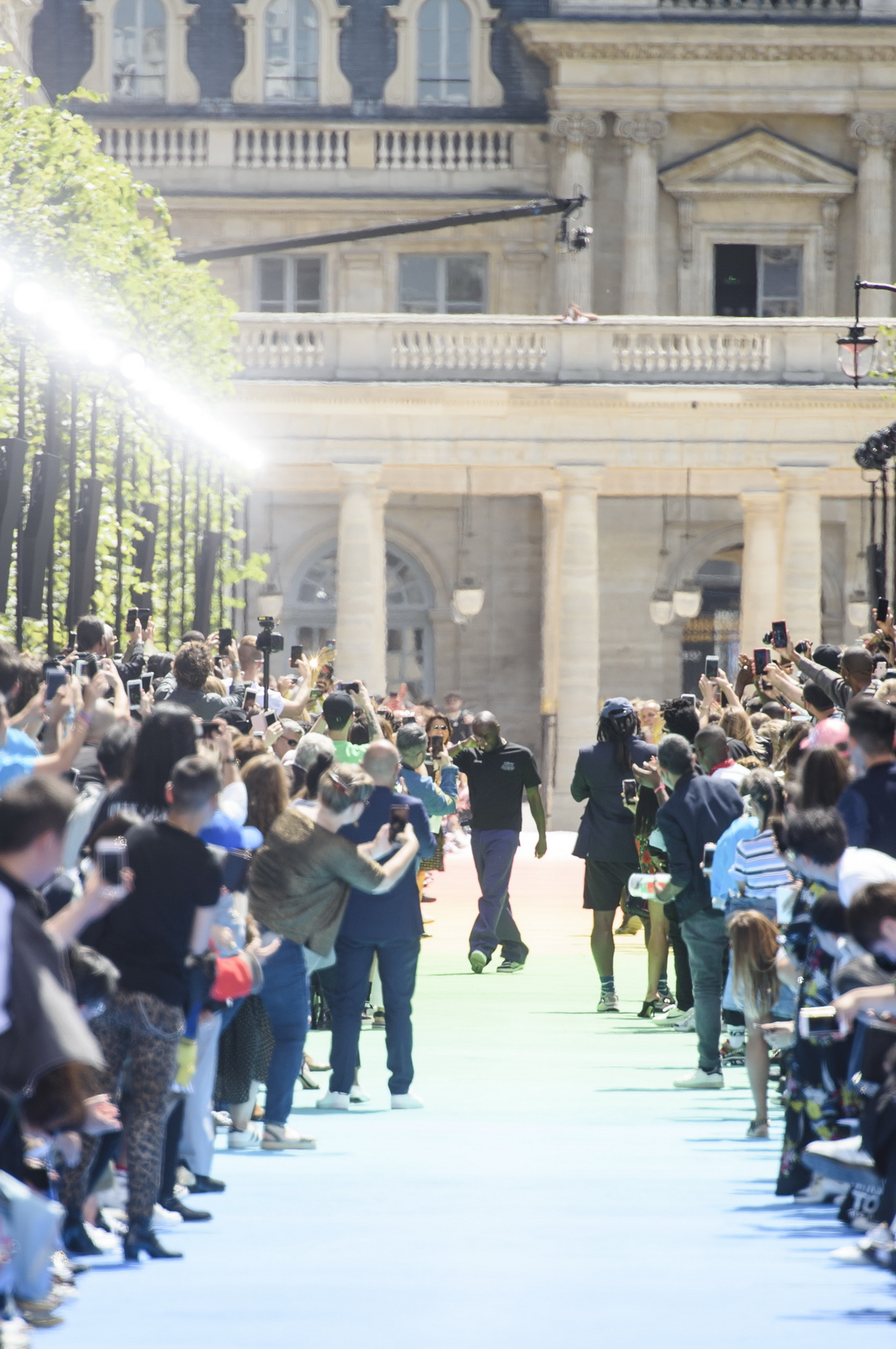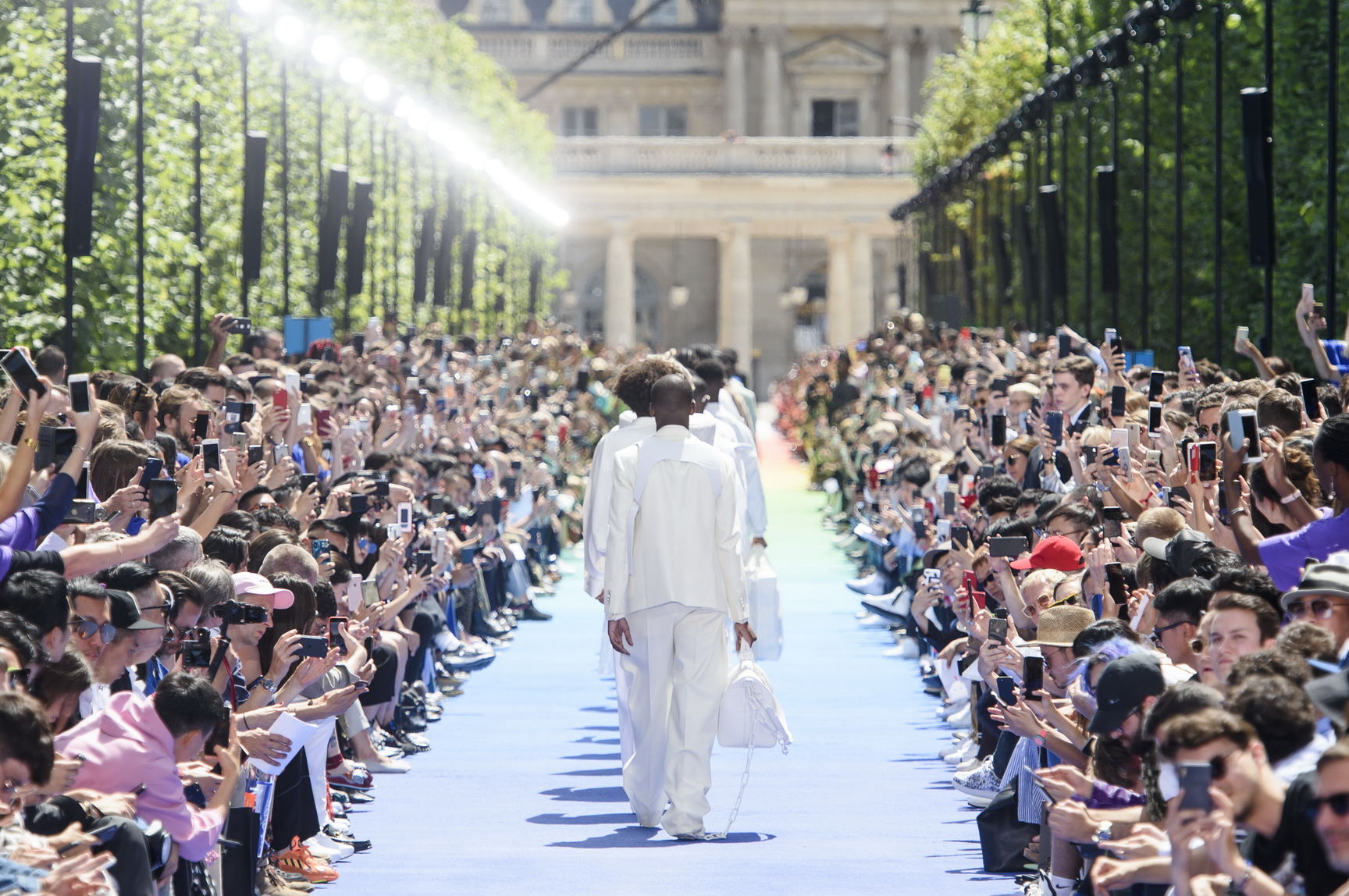The show notes that greeted the guests at Virgil Abloh’s first collection in charge of Louis Vuitton men’s were an encyclopaedic A-Z; it was The Vocabulary According To Virgil Abloh, and it crystallised just why there is such interest around the designer and his rise to Louis Vuitton. In those notes Virgil spoke on everything from the ironic possibility of the collar, the symbolism of Dorothy finding herself in Oz, and the new relationship between designer and consumer. They spoke with trademark ironic detachment, but beneath the words’ cool surfaces was actual unbridled joy at the fact that Virgil Abloh has ascended to this position, at this house, at this time. The ascent of millennial from vilification to veneration.
It was a celebration. It felt like a moment unlike anything we’d seen in fashion before, because it was a moment not so much about fashion as clothes, but about the world we live in. It was about how culture is changing and it was about hope and beauty and diversity and the possibility and dreaming. It was a moment about the shifting genres of fashion, the new meaning of luxury, the power of irony, the respectability of homage and reference. It was about the power of new technology, of speaking directly to youth, of knowing how to build your brand in a way that communicates with the kids, of breaking down the walls and creating something new.
Two days earlier Virgil had presented his Off-White collection to a mixed critical response; the day after that Raf Simons returned to Paris, continuing to dance an elaborate love-hate-tango with Virgil. “We need a new outline, a new shape,” Raf explained after his show. Speaking to a boredom with the luxury-streetwear-fashion-hyperbole. “There are too many hoodies with prints out there. Something needs to shift,” he said. Raf’s collection of nightclub new wave couture sought to move beyond streetwear’s democratic prosaicness, find a new aesthetic and a new mode of communication. A day later, Virgil seemed to be doing the same. Then came Kim Jones’s debut at Dior Homme, and Matthew Williams’ Alyx staged his brand’s first show with Kanye West and Virgil both sitting in the front row, watching on.

Between these designers’ shows we witnessed the collapsing distinctions in fashion and the creation of a new reality. It was Virgil’s Louis Vuitton debut that stole the headlines, of course, the most anticipated and awaited show in many, many years. Hype feeds on itself, growing bigger and bigger, but the hype that engulfed this show in a cavalcade of endlessly updating Insta stories was born out of the fact that few shows provide such an opportunity for a shift of such scale. On such a platform. It was hyped because this was about more than just the possibility of a new fashion aesthetic, but a shift in fashion’s entire attitude. A movement towards something more open, more inclusive, more diverse.
“The outsiders have not just been granted access to the corridors of power, but are actually in power. It’s been coming.”
In Virgil’s shownotes he defined irony as both “The philosophy of a new generation” and “The presence of Virgil Abloh at Louis Vuitton.” Luxury as “A label determined by values, codes and qualities, its use and definition were the privilege of few until a new generation conquered its dominion and shifted the paradigm for good.” Streetwear as “A predictable clothing genre in a renegade designer’s debut collection as part of the fashion establishment, but one whose sportswear properties are undergoing a critical transformation into luxury.” He coined Margielaism as the religion of young designers like himself, and millennials as his audience (although stressing he wasn’t one), and normcore the irony of a generation raised on extravagance.
Virgil had hinted at a shift in a preview piece that ran in the Financial Times. “The genre of fashion design that I come from is no longer satisfied by just being new,” he told Charlie Porter in the FT. “I feel there’s a new establishment happening. Now is the time to be assertive. The line has been crossed. Enough shirts have been sold and enough Instagram posts have changed the ecosystem, so you can’t go back.” Virgil at Louis Vuitton personifies this changed ecosystem. Which is to say that now, in fact, it is simply, the ecosystem. The outsiders have not just been granted access to the corridors of power, but are actually in power. It’s been coming.

Fashion has risen to become one of the most dominant and interesting and youthful artforms. Much of that rise has been down to the pluralistic power of “streetwear” as something opposed to the history and traditions of Parisian ateliers. Streetwear was easy and chill and free and real and open to everyone and this openness led to success, and fashion wanted that, and slowly the spaces that separate those two opposites have been obliterated.
“Fashion now is inviting 3000 people to your show. Parading an incredibly diverse cast of models from around the world down a rainbow hued runway. Hugging your best mate. Supporting each other.”
Fashion is the most urgent artform for right now, because as an artform it is tailor-made to exist in the spiralling feed of images we traverse through in our daily lives. It flattens old and new and every drop and every collaboration and every editorial into one constantly updating scroll. Instagram has done as much to open up fashion as any one single person, but Virgil has been at the forefront of that opening.
As fashion has travelled, over the last half-decade or so, from its exclusive niche towards something more open and youthful and democratic, it has slowly and naturally taken in the concerns and desires of our generation. Fashion is no longer about bitchiness, rudeness, egos, exclusivity, exclusion. Things the new generation have little interest in. Fashion now is inviting 3000 people to your show. Parading an incredibly diverse cast of models from around the world down a rainbow hued runway. Hugging your best mate. Supporting each other. An “untrained” fashion designer, the son of Ghanaian immigrants, in charge of pointing everything that LV represents towards the needs and desires of the youth.
“What’s great is now the designers who thought they could never even think about such a position can now think about it,” Naomi Campbell said to i-D’s Matthew Whitehouse before the show. “It’s all possible. Besides Virgil being great at what he does, he’s opened the minds of so many people that it’s possible and this can happen to you… This is what I like about it. It gives hope!” Which is really what made this show such a milestone. Hope and possibility become real, not just a dream.

